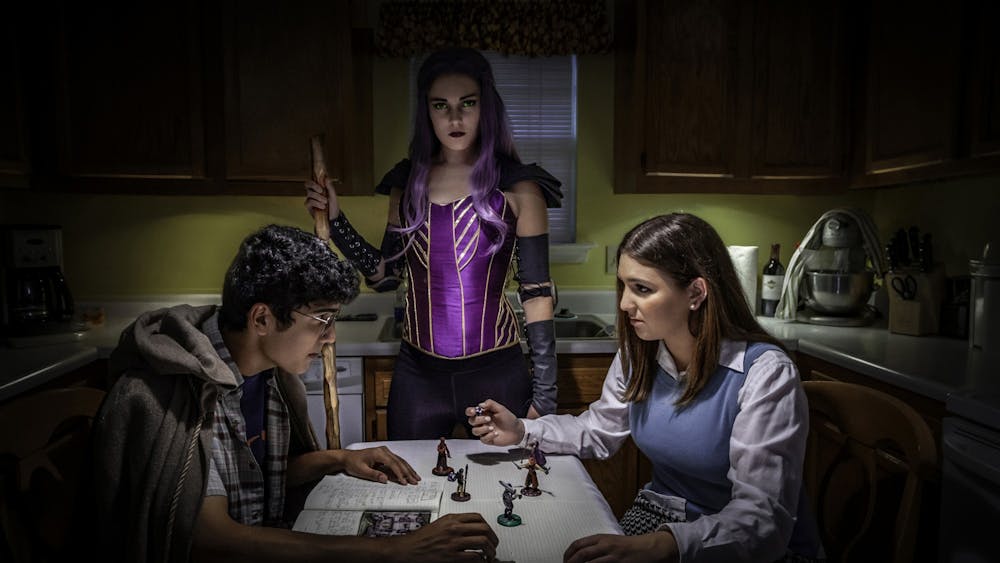“She Kills Monsters,” a play written by Qui Nguyen, takes audiences into the fantasy world of the role-playing game “Dungeons and Dragons.” The play follows Agnes, an average woman living an average life before her entire family — including her younger, teenage sister Tilly — is killed in a fatal accident soon after she graduates high school. After the accident, Agnes begins to play “D&D” — Tilly’s favorite pastime — to connect with her sister in a way she was never able to do in real life. The sisters were not close while Tilly was alive, as Agnes focused on boys and school, and considered her little sister to be too nerdy to be paid any attention. However, while playing this role-playing fantasy game, Agnes begins to confront and recognize her grief, while learning more about her estranged sister than she could have ever imagined.
“She Kills Monsters” is currently being presented by the drama department and is staged in the Ruth Caplin Theatre. The theatre itself helps bring the role-playing part of the game to life, as the audience gets an almost 360 view of the stage, allowing for an immersive experience by letting the audience see what is going on from almost every angle.
The play also boasts an impressive set design. The stage had to believably switch from boring Ohio in the 1990s to the dynamic and magical world of “D&D” in seconds — which is no easy feat. This was managed impressively through a combination of costumes, lighting and digital media. Projectable platforms are installed in the background of the play where characters are introduced, the landscape is displayed and context is given. The lighting would switch from the unflattering fluorescent glare of high school hallways to flashing colors of a magical forest in seconds.
Another standout part of production was the attention to detail in the costume design. The costumes simultaneously enhanced both the realistic and un-special parts of everyday high school life as well as the awe-inspiring wardrobe and armory of the fantasy characters in “D&D.” Monsters came to life in a variety of ways, whether it be three puppeteers handling one tiny puppet demon or a team wheeling a giant Jell-O monster around the stage. The design and production elements of the show were by far the most thought-out and impressive on the stage.
Constant references to the ‘90s were made throughout the show, giving the audience a sense of nostalgia and remembrance, much like the game itself. The soundtrack gave a clear timeframe for the audience, as characters were introduced via songs like “...Baby One More Time” and as monsters were defeated in a very ‘90s dance battle that featured a medley of top hits from the time.
The design of the show does everything it can to emphasize the difference between the real world and Tilly’s fantasy world. In the world of “D&D,” Tilly is revered and surrounded by friends. She is able to overcome almost every obstacle. Tilly is in control of every element of the world she has created. The audience and her sister, Agnes, soon learn that this was not the case in the real world. The world of D&D is an inclusive space — a haven where people are able to freely express themselves in any way they please. As such, queer narratives and themes are central to the show, which broadly examines the experience of being different. In the fantasy role-play world, people are able to act as their authentic selves in a way that they cannot do in the oppressive setting of a suburban high school.
However, it is in Tilly’s fantasy world where Agnes connects with her sister authentically, and is able to understand why she was so attached to the game. Director Marianne Kubik said the show is supposed to express the experience of teenagehood.
“I would like [audiences] to see what it's like to be an adolescent and feel like they are the ‘other,’” Kubik said. “They don't fit in and are constantly being told by their peers that they don't fit in.” She sees D&D as an escape from this in the play. “[The game is] how they negotiate, trying to be themselves and explore who they are … to have a chance to have experiences in a way that they have that they find that they're not able to do in real life, because of social constraints.”
The space certainly gives that to Agnes, who desperately uses the game to bond with her late sister and must grapple with the fact that she did not put in the effort to get to know her sister while she was alive. Tilly’s world is a safe space for outsiders and it highlights the wish-fulfillment element of fantasy role-playing games, where the hero gets the girl, destroys bullies and lives to see another day.
“She Kills Monsters” runs through Saturday Nov. 23 in the Ruth Caplin Theatre.







